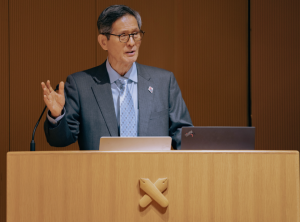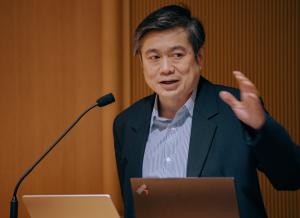*日本語の記事はこちら
*Click here for the second half of the event report.
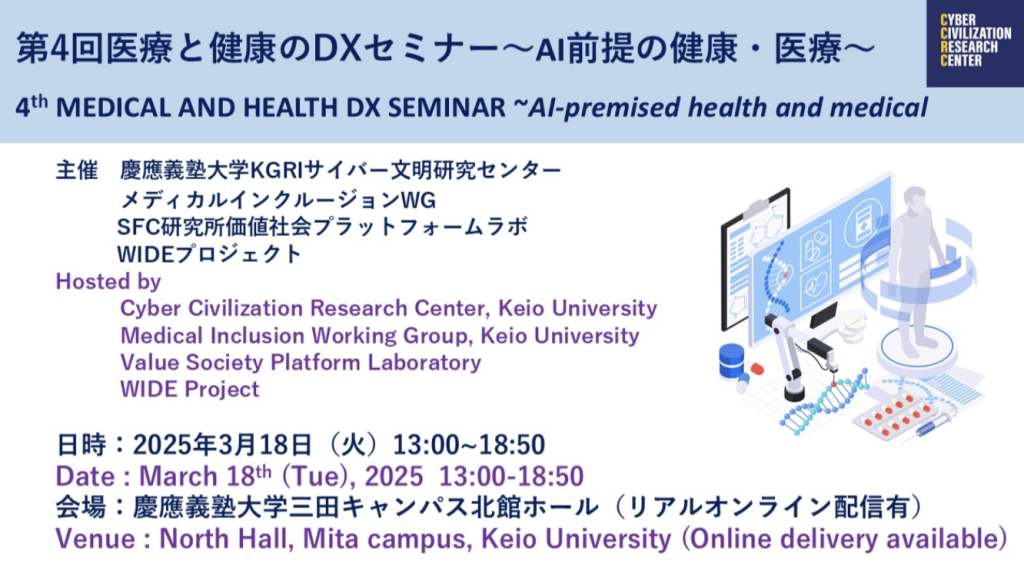
hosted by Cyber Civilization Research Center (CCRC), Keio University
Co-hosted by the Medical Inclusion working group, CCRC
Value Society Platform Laboratory, SFC Research Institute
WIDE Project
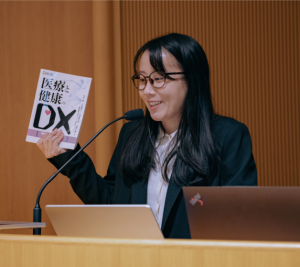
Hitomi Sano, Project Researcher, Graduate School of Media and Governance, Keio University
“Introduction”
At the beginning of this seminar, I would like to provide a brief introduction to the background of the organization and the role of the Center for Cyber Civilization Research (CCCR), our host institution.
CCRC is co-directed by Professor David Farber and Professor Jun Murai, both of whom have been instrumental in building the foundations of the Internet, often referred to as the “Grandfather” and “Father” of the Japanese Internet. The center views the societal transformation brought about by digital technology not merely as innovation, but as a civilizational shift. As AI and digital technologies increasingly engage with fundamental aspects of human life, we believe we are now in a transitional phase toward a new form of civilization.
Among the core pillars of this shift, health and medicine stand out as essential components. They are no longer just matters of professional expertise, but subjects that must be reconsidered from a broader civilizational perspective. Behind CCRC’s approach lies the intellectual legacy of Yukichi Fukuzawa, the founder of Keio University. Known for introducing the concept of “civilization” in Japan’s modernization, Fukuzawa also emphasized the societal impact of information—what we might today call media and communication—and warned of the emotional volatility of the public in reaction to new forms of information.
This seminar series was launched during the COVID-19 pandemic and now marks its fourth session. To date, over 40 experts have presented their perspectives, and the content of previous sessions has been published in reports and books. These discussions aim not only to document use cases in medical digital transformation (DX) but also to contribute to the broader rethinking of societal design.
We look forward to continuing this dialogue with all of you as we explore the possibilities of a new civilization.
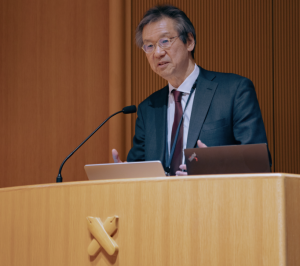
Masayuki Amagai, Vice President of Keio University
“Welcome Message from Keio University”
Since its establishment in 2018, the Center for Cyber Civilization Research (CCRC) at Keio University has been committed to studying the societal transformations brought about by digital technologies and to widely sharing its insights with the public.
As part of this mission, a new research hub—the CCRC Project Room at Haneda Campus—was officially opened on March 8, 2025. Given its strategic location in Haneda, the campus is ideally positioned to foster international collaboration, particularly across the Asia-Pacific region. It will serve as a vital base for reimagining the future of digital society from a global perspective, contributing to both policy development and technological innovation. Under the joint leadership of Professors David Farber and Jun Murai, I am confident that CCRC will continue to grow and evolve.
On March 16, renowned historian Yuval Noah Harari visited Keio University and participated in a dialogue with President Ito, held in the Kitakan Hall, followed by a question-and-answer session with students. In his latest book, Nexus, Harari explores with sharp clarity how we have arrived at today’s highly uncertain state of society. One key insight relevant to this seminar is his perspective on how the nature of information has changed throughout history.
Traditionally, universities and educational institutions were seen as places that collected and curated information, libraries being a prime example. People would come to these spaces to study and generate knowledge. However, this traditional role of universities is diminishing in today’s age of information overload.
In this age of excess, truth and fiction are intermingled. Truth tends to be complex and challenging to grasp, while fiction is often simple and easy to understand. Moreover, truth can be painful, whereas fiction is comforting. Communicating truth requires significant effort and resources, while fiction can be created effortlessly inside a single person’s mind, at little to no cost. As a result, fiction spreads far more easily. And what drives this dissemination is no longer people, but AI-powered algorithms. These algorithms are developing at an extraordinary speed, making it increasingly difficult to predict their impact on humanity.
Amid this uncertainty, Harari emphasized to our students the enduring importance of trust between human beings.
This, I believe, connects directly to the theme of today’s seminar: the digital transformation (DX) of healthcare and medicine. As digital technologies—especially AI—rapidly transform medical practice, we face the urgent need to seek accurate information and distinguish it from misinformation. While AI may accelerate diagnoses and improve the efficiency of healthcare systems, we must also carefully examine the fairness of AI-generated medical data and algorithms, as well as the potential risks posed by misinformation to both medical practice and personal health.
I sincerely hope today’s symposium will serve as a meaningful step toward shaping a better future for healthcare and well-being. With that, I would like to officially open this seminar.
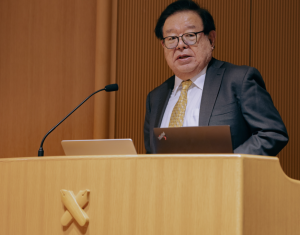
Jun Murai, Professor and Co-Director, Cyber Civilization Research Center, Keio University
“Host’s Address”
How digital technologies can contribute to society have changed rapidly over the years. When we were building the Internet, we used the slogan in 1995: “The Internet is for Everyone.” At that time, less than 1% of the world’s population was using the Internet. Looking back, that might have seemed like an overly ambitious goal. But even in 1995, we were already envisioning and building a system to connect all of humanity to the Internet. Now, 30 years later, in Japan, more than 100% of the population—when counted by the number of devices—has access to the Internet.
Based on this reality, we’ve continued to ask what kind of societal transformation is needed, under the framework of digital transformation (DX). The dream that motivated the development of the Internet was that people’s knowledge could be shared globally through this networked environment. From the outset, I believed that the Internet would undoubtedly make a significant contribution to the field of healthcare.
At the same time, medicine must be approached with great caution. Data sharing carries risks, and as a result, the pace of digital transformation in healthcare has tended to lag behind that of other sectors.
However, during the COVID-19 pandemic, public understanding of digital technologies advanced significantly. Some say that two decades’ worth of progress took place in just two years. In Japan, in particular, I believe our historical understanding of the relationship between healthcare and digital transformation has undergone a dramatic shift. Recognizing this as a historical turning point, we invited Dr. Shigeru Omi, who played a leading role in Japan’s COVID-19 response, to deliver the keynote address for this seminar.
As AI rapidly spreads, the healthcare sector is also being affected. Digital technologies are increasingly being utilized in clinical settings, while society at large is experiencing reactions, some of which could be described as confusion or even panic. As the development of AI advances rapidly, we now face the challenge of integrating these technologies effectively and ethically into healthcare systems. AI is becoming a central theme in the digital transformation of healthcare, and I believe it is essential that experts in both AI and medicine come together as a network to help shape its development.
Shigeru Omi, President of the Japan Anti-Tuberculosis Association
“Expectations for AI and DX from the perspective of public health experts”
I am not an expert in AI or digital technology, but I would like to share my experiences from the field during the COVID-19 pandemic and, in conclusion, offer my proposals and hopes for the future of medical digital transformation (DX).
Despite repeated strong recommendations for the digitalization of healthcare—especially following events such as the response to novel influenza outbreaks—Japan had made little actual progress. As a result, by January 2020, there was a significant gap in preparedness between Japan’s and South Korea’s COVID-19 response headquarters.
The most significant frustration I personally experienced was the lack of information. We, the experts, did not receive the necessary data. Yet, the government asked us for advice on what actions to take. We were placed in a severe dilemma: providing recommendations with extremely limited data.
Examining global pandemic strategies reveals a range of approaches. For example, Sweden took a rational stance, asserting that suppressing infections is not possible, while China pursued a zero-COVID policy through prolonged lockdowns. Japan, on the other hand, did not follow either extreme, nor did it attempt a middle ground, but instead adopted a uniquely Japanese approach.
The most important priority was to reduce the number of deaths and avoid the collapse of the healthcare system. While balancing the economy was important, if the healthcare system collapsed, neither economic activity nor infection control could be sustained. Thus, we did not aim for zero deaths or zero infections. Instead, we moved forward with a philosophy that accepted a certain number of cases and deaths, so long as we could prevent the medical system from becoming overwhelmed.
Japan ultimately recorded one of the lowest COVID-19 mortality rates globally. In Europe and the United States, the number of deaths was already high in the first year. For instance, in the UK, a large portion of the population was infected in year one, resulting in many deaths and the near-collapse of the healthcare system. In contrast, Japan saw more deaths in the third year, mainly because elderly individuals became infected as time passed and their physical resilience declined.
One unique characteristic of Japan’s response was taking strong measures preemptively when healthcare strain appeared likely, even when deaths were still low. For example, the first state of emergency was declared on April 7, 2020, during the first wave. This was because only a small number of hospitals were able to handle COVID-19 patients, and it was necessary to prevent a collapse in those limited medical facilities.
Japan repeated cycles of strong interventions followed by relaxation as infections subsided, then renewed action as cases rose again. This “hammer and dance” approach became a hallmark of Japan’s response.
So, how did this approach impact GDP compared to other countries? Since Japan did not remain in a continuous lockdown but instead implemented a flexible response, the negative impact on GDP, averaged over three years, was roughly in line with that of Western countries.
Another crucial point was the impact of information and digital tools on public behavior. Even before the state of emergency was declared, many people had begun wearing masks voluntarily. This behavioral change was triggered by the dissemination of information, including death tolls and healthcare strain data, in newspapers and online. Public cooperation began even before government mandates took effect.
We also noticed that the effect of such information varied by age group. Elderly people were more responsive, perhaps because they perceived higher personal health risks. Younger individuals, by contrast, may have believed the threat did not concern them.
Although Japan’s medical care is among the best in the world, the healthcare system was not designed for pandemics—it had been optimized for an aging society. The pandemic exposed this mismatch, along with a lack of digitalization in medical systems, as a core reason behind the strain on healthcare resources.
As mentioned earlier, my major frustration during the pandemic was the lack of available data. I believe two key issues caused this.
First, the handling of personal data varied significantly across local governments. Healthcare professionals, such as nurses and public health workers, collected detailed information through direct interviews with patients, including the routes of infection. However, due to inconsistent regulations on personal information and the tendency to apply the strictest standards, this rich data at the local level was never shared with experts like us. We only received the minimum and most restricted level of information.
Second, Japan lagged in the digitalization of healthcare. In 2020, many of the response headquarters were staffed by experts and even graduate students. Government officials were overwhelmed, particularly with issues such as cruise ship outbreaks. In the field, information was often gathered from faxes, and data tables were manually created. Sometimes we relied on personal connections to get necessary data—unthinkable in the 21st century. I must emphasize the immense stress this placed on on-site experts.
Finally, let me conclude with a proposal for medical digital transformation (DX). The priority must be to establish a system that enables rapid acquisition of essential epidemiological data. For this, we need both the digitalization of medical information and a nationwide, unified system in Japan.
However, cooperation between IT experts and public health professionals remains inadequate. The Internet was initially intended to be a cross-disciplinary system; however, in Japan, medical administration is fragmented among various government ministries. This segmentation narrows perspectives and discourages collaboration across fields. These divisions are not just a problem of bureaucracy—it is a national issue.
We must work together—government, private sector, and academia—to find the most optimal solutions as a whole. I hope that all participants in this seminar can collaborate to uncover and address the latent issues in medical AI and digitalization, and translate that knowledge into informed policy proposals for the future.
Joi Ito, President, Chiba Institute of Technology
“The Architecture of Health and Medical Data in the Age of Blockchain and Probabilistic Programs”
“Probabilistic Programming” refers not merely to programming with probability, but more broadly to methods that model uncertainty and make decisions based on incomplete or imprecise information. This is an area where today’s mainstream AI technologies tend to struggle.
Historically speaking, in the 1990s, probabilistic programming was a central approach in AI research. However, its use of complex statistical models posed mathematical and practical challenges, especially in terms of scalability and manual implementation. Around 2013, neural networks began to attract increasing attention, and many researchers who had worked on probabilistic approaches in the 1990s shifted their focus to neural networks in the following decade.
Given this contrast, let me elaborate on the fundamental differences between neural networks and probabilistic programming. Despite the word “neural,” today’s neural networks operate very differently from actual brain function. On the other hand, probabilistic programming more closely resembles how the human brain performs cognition. This has led to a resurgence of interest in probabilistic approaches.
Human reasoning doesn’t follow strict logic; instead, it involves ongoing probabilistic estimation. We constantly revise internal models as new information becomes available. Medical diagnosis is a good example: physicians estimate the probability of various conditions based on a patient’s symptoms and medical history, and then continually revise those estimates as additional data becomes available. This kind of Bayesian reasoning is difficult to implement using current neural network models.
In a sense, today’s neural networks excel in tasks such as translation or other specialized applications, and are suitable for developing general-purpose intelligence when the specific purpose is unknown. However, when the task is well-defined, probabilistic programming can be a more appropriate approach. By integrating mathematical models of probability into programming languages, it enables more flexible and structured forms of inference.
Additionally, human cognition is modular—we combine distinct concepts to navigate new situations. Probabilistic programming supports this modularity, making it a potentially powerful tool for modeling human-like reasoning. Unlike purely statistical approaches, it enables us to gain a deeper understanding by combining structured pieces of information. This is highly efficient and well-suited for applications such as object recognition, structured data modeling, and analysis of complex hidden structures.
Neural networks typically require large amounts of data to identify patterns. In contrast, humans—and probabilistic programming systems—can begin building models with relatively little data and refine them as more becomes available. These models can operate with lower data requirements and less powerful computing resources. The human brain, for instance, consumes roughly the same energy as a light bulb, yet performs remarkably sophisticated reasoning. This efficiency arises from a more structured learning process than what current neural networks employ.
Moreover, probabilistic programming allows humans to interpret complex models directly from source code. For example, a physician can review the code and say, “Here’s the anomaly” or “This change was triggered by X.” This is in contrast to earlier ‘expert systems,’ which were often challenging to interpret due to heavy logical dependencies. Probabilistic programming can be seen as a new form of expert system, capable of handling complexity and uncertainty more effectively.
While the term “LLM” (Large Language Model) is now standard, I believe we should also focus on building population-scale models of humans. I’ve proposed the term “Large Population Model” (LPM) to describe this concept. By combining LLMs with probabilistic programming, we can unlock new possibilities. For example, LLMs can be used to structure text data, which can then be integrated with large-scale databases to form an LPM—a foundational model that represents the diversity of human characteristics.
Even in the presence of bias in statistical models, probabilistic programming allows us to unify disparate data sources, formulate hypotheses from limited data, and make inferences. Individual datasets inevitably contain bias, but by integrating multiple databases, we can build models that mitigate these biases.
This approach also utilizes synthetic data. In cases where clinical trial data is limited—say, due to a small patient population—statistical models can generate synthetic data to supplement the analysis. Similarly, in regions lacking specific disease data, synthetic data enables high-accuracy prediction, even from limited real-world samples.
Another point is that the use of synthetic data also supports privacy. It reduces the need to gather sensitive personal information from specific communities, while still enabling meaningful analysis. This is especially valuable when direct collection of identifiable data is not feasible. Namely, probabilistic programming treats data in a structured way, which has significant implications for personal information management. Today, with privacy regulations such as Japan’s Personal Information Protection Law, there’s growing caution around handling identifiable data. However, LLMs, being inherently opaque, make it difficult to control what personal information is retained or inferred. As a result, there is a trend toward avoiding any training on personal data.
In contrast, probabilistic programming enables fine-grained control over attributes in synthetic data. For instance, we can prevent a model from revealing correlations between age and income, thereby reducing the risk of re-identification of individuals. This enables flexible, community-specific data governance and utilization. That is, instead of blanket restrictions like “this data cannot be used,” we can mathematically guarantee that sensitive attributes cannot be extracted, even when diverse data types are integrated. This opens the door to merging hospital datasets across regions and potentially across countries, enhancing the global utility of health data while protecting individual privacy.
Finally, applying AI in real-world medical settings necessitates bridging the gap between the individuals who collect the data and those who develop the models. Engineers must work within medical institutions and collaborate closely with healthcare professionals. However, in Japan, the compartmentalization of disciplines remains a serious obstacle—medicine and engineering are still treated as separate domains.
Japan possesses many cultural and systemic traits that make it well-suited to AI development, yet these advantages are not being fully leveraged. To promote the practical application of AI in healthcare, we must establish mechanisms that bridge academia and the field, thereby fostering the integration of technology and medicine.
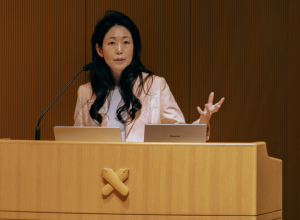
Rami Suzuki, CEO of ARC Therapies, Inc.
“The Future of AI x Healthcare: Towards Optimization and Personalization”
In my youth, I resolved to devote myself to curing cancer, and for many years I worked in drug discovery. However, more than a decade ago, I began to feel a growing concern that, given the significant lack of necessary information, a cure for cancer would be challenging to achieve if we continued on the current trajectory.
I concluded that to identify the optimal treatment for each patient, it is essential to utilize health-related information more effectively. Based on this belief, I launched a consortium involving industry, government, and academia, and submitted a policy proposal to then Prime Minister Shinzo Abe.
One of the biggest challenges in clinical practice today is the lack of solid evidence. It is often difficult to determine whether a particular drug is truly effective. To address this issue, we must develop a system that demonstrates the proof of treatment efficacy, discontinuing treatments when they are ineffective and continuing them when they are effective.
Furthermore, by combining this data with diverse patient profiles, it becomes possible to visualize the effectiveness of treatments. If this approach is further developed, we can use data before treatment begins to identify the most suitable therapy. This would also help reduce healthcare costs.
ARC Therapies is a venture company spun out of the National Cancer Center of Japan. We aim to cure cancer by taking an integrative approach that incorporates three elements: immunity, genetics, and metabolism.
We apply AI in our work to conduct comprehensive analyses of immune, genetic, and metabolic data.
CAR-T therapy is a groundbreaking treatment that has the potential to cure cancer in certain patients completely. However, it also poses a major challenge due to its high cost—the current treatment price ranges from 40 to 50 million yen (approximately $250,000–$320,000). Reducing this cost while improving clinical practicality is a key focus for us.
To that end, we are developing a system that enables centralized quality control, making it feasible for major university hospitals and cancer centers to deliver this therapy efficiently and effectively.
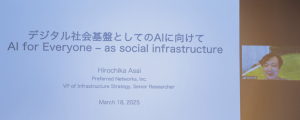
Hiroshi Asai, Senior Researcher and VP of Infrastructure Strategy, Preferred Networks, Inc. (Online)
“AI for Everyone – as social infrastructure”
Today, I’d like to talk about AI as a foundational infrastructure for a digital society.
Historically, there has been a significant gap between the physical world and digital space. However, by leveraging our AI technologies, we can now digitize the 3D structure of the physical world from video data and re-render it visually. We refer to this process as “4D scanning.”
For instance, while current regulations prohibit flying drones over railway tracks, we can use generative AI to recreate those environments digitally and generate realistic video content without physical drone footage.
AI is also being applied across a wide range of industrial domains. Simulations that once would have taken hundreds of years can now be completed in as little as 35 minutes.
More recently, the use of foundation models has gained attention. By applying foundation models, including large language models (LLMs), we can bring digital representations—especially in video—closer to real-world physics. Programming, which was once reserved for digital experts, is now accessible to professionals in other fields, such as science, who can use LLMs to perform computations and write code with AI support.
Another area attracting interest is the agent model. This refers to personalized professional AI agents tailored to individual users. Especially when dealing with sensitive information, such as medical data, agent-based systems can process data internally without transmitting it externally. I believe these agent-based AI systems will play an increasingly important role in the responsible handling of personal data.
As part of my academic work, I’ve also been involved in the WIDE Project, initiated by Professor Murai. In 2023, we supported an experimental remote surgery using a robotic system called Hinotori. In this experiment, a cockpit was set up in Singapore, and a surgical robot was placed in Nagoya, allowing us to evaluate the impact of latency on remote surgery. In robot-assisted surgery, what was previously an analog operating environment is now fully digitized. This opens up possibilities for AI to assist in surgery and enhance diagnostic precision.
AI is evolving rapidly and being applied across more and more fields. One of its key roles is to bridge the gap between the digital and physical worlds. Technologies that translate digital computations into intuitive real-world or natural language outputs will continue to evolve and play an increasingly important role in our society.

Kunihiro Tanaka, President and CEO, SAKURA Internet Inc.
“The Future of AI Utilization Opened by the Japanese Medical LLM”
I founded SAKURA Internet 29 years ago when I was still a student. Since then, we’ve been providing servers and computational resources. As part of this, we’ve built an extensive GPU infrastructure and are currently engaged in developing an original large language model (LLM) for medical applications.
In line with Japan’s national policy to strengthen domestic computational capacity, we began implementing the Cloud Program last year, resulting in the deployment of thousands of GPUs. We currently have approximately 3,000 to 4,000 H100 units installed in our data center in Hokkaido.
Initially, Japan’s government cloud initiative (the “Government Cloud”) included no domestic companies. However, after the government opened the opportunity to local firms, we applied and were ultimately the only domestic provider selected. Although I feel it’s a problem that so few Japanese companies are involved, we are currently the sole domestic participant in this field.
I’ve long believed in the importance of building our own computational infrastructure. Early on, I built everything myself, including connecting to NSPs and IXs, and operating BGP. We’ve also developed our own servers and recently, a virtualization-based cloud platform. While we don’t manufacture GPUs, we’ve developed the software for GPU-based cloud hosting entirely in-house.
Japan must be not only a user of technology but also a creator of it. As a tech-driven nation, Japan must not stop at simply utilizing digital and AI tools; we need to develop and grow these technologies as domestic industries. Currently, Japan runs a digital trade deficit of 6.3 trillion yen, meaning the more we use digital tools, the more we rely on overseas providers and worsen our trade imbalance. While digital transformation (DX) may improve productivity, that alone is insufficient. We must also become a country that earns through digital and AI technologies. It’s problematic that we are offsetting this deficit with labor-intensive industries, such as tourism, which contributes to stagnant wages in Japan.
This is why we’ve taken on the task of developing a medical LLM as part of the SIP (Strategic Innovation Promotion Program) Integrated Healthcare System. Our aim is not just cost reduction or operational efficiency—we believe the actual value of AI lies in creating new value.
For example, I currently live in Okinawa, and I’ve noticed the disparity in medical quality compared to Tokyo. In some remote islands, patients may not survive even after being airlifted by doctor helicopters. This isn’t a problem that money alone can solve—we need technology. AI-powered systems such as robotic medicine must be socially implemented to ensure that people in remote areas can access the same quality of care as those in urban centers.
A critical issue in medicine is bridging the gap between prevention and treatment. To support physicians in making informed decisions, we need systems that can leverage electronic health records (EHRs) and massive medical knowledge. These systems must be developed at a national level.
Most general-purpose LLMs are trained on web data. The Web is an extraordinary invention—it connects information via links, creating a single unified graph of knowledge, the very essence of “the Internet.” However, medical data is mainly absent from the Web. It’s not searchable online. I believe that the next generation of LLMs must go beyond the public Web and incorporate non-public, domain-specific knowledge, and medicine is at the forefront of this shift.
That’s why we are working on a project to develop a Japanese medical LLM by leveraging EHRs in collaboration with various stakeholders. By combining this with medical big data analysis, we aim to develop a system that enables doctors to deliver more accurate and informed diagnoses.
While general-purpose AI is already integrated into daily life, the medical field poses unique challenges. Medical data is not found on the Web; it’s highly confidential and must be handled in closed environments. The requirements for medical LLMs differ significantly from those of general LLMs. But if we can address these challenges, the rewards are significant—not only in terms of better healthcare delivery, but also in areas such as drug discovery and the development of new medical technologies. What was once confined to laboratories is now being increasingly shifted to computational research and development environments.
Whereas traditional industries were built around iron and oil, today’s core industries rely on semiconductors and computational power. While the U.S. dominates this space, Japan is now securing the second-largest computing capacity in the world. China used to be strong in this area, but Japan is now taking the lead in specific GPU deployments.
In this context, harnessing computational resources, technical expertise, and R&D to support public health and safety has the potential not only to enhance national competitiveness but also to become a new export industry for Japan.

Hiroki Ishida, CEO and Chief Architect of FreeBit Inc.
“Decentralized PHR Architecture in the AI-driven Health and Medical Era: A Case Study”
I originally belonged to Professor Murai’s research group and have been involved with this seminar series since its second session. Today, I would like to share the outcomes of a project that originated from this very seminar — an example of how ideas discussed here have been successfully implemented in the real world.
I believe the structure of today’s seminar has been thoughtfully crafted. For example, while Mr. Tanaka from Sakura Internet presented a project based on high-performance data centers and computing resources, our initiative takes the opposite approach. We are building a decentralized Personal Health Record (PHR) architecture by connecting small-scale computing resources. This project is a collaborative effort with Fujita Health University, aiming to explore how personal health records (PHRs) — which contain personal health data — can address privacy issues and contribute to patient-centered care.
FreeBit has long been engaged in the development of core Internet communication infrastructure. In the realm of computer science and network architecture, we’ve witnessed repeated cycles of centralization and decentralization. The Internet began as a decentralized network, but due to issues such as latency, synchronization, and reachability, centralized infrastructures have since emerged. As a result, new challenges have arisen regarding personal data governance by large platform providers — challenges that are now being addressed under the umbrella of concepts like Web3.
At FreeBit, we have consistently explored how to build decentralized Internet architectures, especially as the world seeks a more careful transition from centralized Web2 systems to decentralized Web3 models. In this context, we are developing decentralized Web3-based architectures explicitly tailored to the healthcare domain.
We consider smartphones to be critical computing assets. While designing and manufacturing smartphones ourselves, we’ve focused on developing AI systems that run directly on these devices, rather than relying on centralized servers, to allow personal data to be utilized without ever leaving the device.
We are now extending these capabilities by integrating edge-based Large Language Models (LLMs) that evaluate safety in conversations. Traditional database systems used on social networking services (SNS) platforms struggle to understand context, often relying solely on keyword filtering. Our edge LLMs can process full dialogues and posts, analyzing them in context to determine safety.
We are also tackling the challenge of protecting medical data. Traditional centralized systems grant administrators broad authority, raising governance concerns. To address this, we’ve developed a blockchain framework that operates on smartphones within a community, making data tampering virtually impossible. Tone Mobile smartphones have successfully run an Ethereum-compatible Layer 1 blockchain, with over 7,000 participating devices, ranking as the third-largest Layer 1 blockchain node network globally.
Additionally, we provide a three-tiered health support service for Tone Mobile users, encompassing prevention, consultation, and monitoring. These services utilize edge LLMs and blockchain technologies to ensure both intelligence and data protection.
This initiative aligns closely with Japan’s “Trusted Web” policy. In collaboration with Fujita Health University, we are exploring how to integrate the “Trusted Web” concept into healthcare, utilizing Web3 technology as the foundation for implementation.
Fujita Health University operates a system called FR-Hub, which converts disparate Electronic Health Record (EHR) systems into standardized data. This data can then be used for PHRs and regional coordination. Leveraging FR-Hub and Trusted Web principles, we are developing a system that enables real-world medical data, such as test results and prescriptions, to be stored directly in a patient’s PHR, rather than remaining within hospital systems.
This means patients can directly manage and access their health data, making it easier to share information with local clinics and other healthcare providers. Furthermore, since each app functions as a node, this system does not require large, centralized management infrastructures. Patients retain full ownership of their data and can grant permissions as needed, creating a truly patient-centric medical infrastructure.
This decentralized model will significantly contribute to the creation of next-generation healthcare ecosystems that empower patients and protect personal health data.
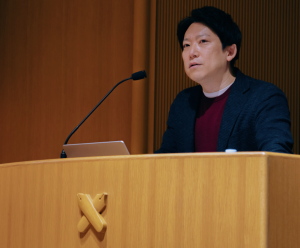
Tatsuhiko Yamamoto, Professor, Graduate School of Law, Keio University
“Privacy, Health Care, and AI – A Constitutional Perspective”
I research the relationship between privacy, technology, human rights, and democracy within constitutional law. Today, I will provide a brief review of the history of healthcare information protection and discuss constitutional perspectives on issues related to medical artificial intelligence (AI).
The Japanese government’s 2024 Basic Policy highlights the importance of utilizing medical data and digital transformation (DX). It sets goals, such as building a national medical information platform to promote the utilization of medical data and the social implementation of AI in hospitals.
In response, the “Next-Generation Medical Infrastructure Act” supports the development of legal frameworks for the use of medical data. Although revised to become more user-friendly, medical professionals may still find challenges. Medical personal information has long been treated as “sensitive personal information” under the Personal Information Protection Act, requiring stricter handling. At the same time, utilizing medical data is socially valuable, necessitating a balance between protecting privacy and promoting its active use.
To address this dilemma, the law established frameworks for using data in a de-identified manner. However, excessive anonymization risks diminishing the value of medical research, and procedural complexity has been criticized as a barrier to progress. In April 2024, the law was amended to permit the use of pseudonymized data—data that retains some traceability to individuals—under specific conditions, thereby facilitating more effective use of medical data.
Previously, Japan restricted the linkage between public databases, such as the NDB (National Database of Health Insurance Claims), and other medical data. The amendment now encourages active data linkage, enabling AI-based disease prediction utilizing electronic health records (EHRs).
While the law and infrastructure, such as the national medical platform and biobanks, continue to evolve, research use hurdles remain higher in Japan than in Europe and the US.
I conceptualize the data world as divided broadly into two realms: the “individual realm” and the “collective realm.” Personal data that directly impacts individuals, such as in direct marketing or targeted advertising, requires strong individual control. In healthcare, personal health records (PHRs) embody this principle, allowing individuals to decide what information to share and with whom.
Conversely, secondary uses, such as research, involve data aggregated at the collective level without direct individual impact. Properly distinguishing these realms is crucial, but in Japan, the boundary often remains unclear in discussions.
Other issues I wish to highlight include “Human in the Loop” challenges, where AI hands control back to humans moments before an accident to shift responsibility. However, humans cannot react in time, rendering them “responsibility sponges.” There is also the concept of the “moral crumple zone,” where humans may absorb blame to protect AI systems, analogous to bumpers absorbing impacts.
These debates are highly relevant in medical AI, raising questions about how much decision-making is delegated to AI, how responsibility is shared between AI and physicians, and how to design interfaces to allow appropriate human supervision and intervention. Physicians should not be mere “responsibility sponges” who bear blame without absolute control.
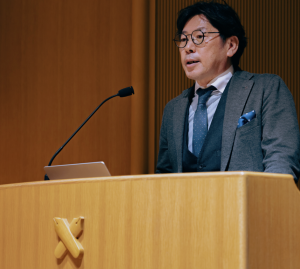
Tomio Morikawa, Assistant to the President of Fujita Health University, Professor of the Department of Real-World Data Research and Development
“Healthcare DX in the Era of Generative AI”
Various initiatives are currently underway in clinical settings to utilize generative AI. Today, I would like to report on several of these practical examples. In healthcare, professionals from a wide range of disciplines, including clinicians, IT engineers, and administrators, collaborate to provide services. Our role as health information professionals is to connect these domains and help deliver better services.
However, medical information systems face several challenges: data sharing is difficult, external data transfer is restricted by security concerns, and data standardization has not progressed sufficiently. At Fujita Health University, we are actively working on solutions that focus on the real-world implementation of technology.
A key consideration is achieving efficiency while keeping costs low and minimizing reliance on vendors. We must also consider physicians’ workflows and the broader context of healthcare management.
Surprisingly, fax machines are still widely used in hospitals. Although electronic medical records (EMRs) have been introduced in many institutions, including university hospitals, data is often printed and handed to patients for physical transport. This is inefficient and wasteful. Ideally, we should enable direct digital-to-digital data transfer.
Standardizing all data across an entire university hospital system is impractical and highly time-consuming. Instead, we focus on selectively standardizing necessary data and creating mechanisms to extract and use it effectively. We are building a data integration platform using the “FR-Hub.” As mentioned in the earlier presentations by Freebit and Sakura Internet, FR-Hub is also being used in personal health record (PHR) initiatives and SIP (Strategic Innovation Program) pilot projects. This platform enables the sharing of EMRs and lays the foundation for broader data interoperability.
Without academic institutions leading this effort, implementation would become prohibitively expensive. Fujita Health University operates four hospitals, with 185 different systems running across them. Including our facility in Haneda, we operate over 200 systems.
Medical IT systems were developed initially from ordering systems used for medical billing (receipts). EMRs were later added to record clinical documentation, followed by departmental systems for testing, prescriptions, and other purposes, which now operate in coordination. To apply generative AI effectively within such systems, the structure of medical data must be carefully organized and structured.
Ideally, all structured data would be standardized and ready for cloud deployment. However, in reality, the biennial revisions of medical billing systems in Japan have resulted in each hospital developing unique, vendor-specific data management approaches, leading to a “Galápagos” syndrome. This fragmentation makes it difficult to transfer data systems directly between hospitals, presenting a major ongoing challenge.
We are conducting demonstration projects for digital data integration in the Nagoya region. As of the end of January, we established a system that allows data from EMRs to be sent through FR-Hub to the national EMR sharing service. Specifically, “three documents and six data items”—including referral letters and discharge summaries—can now be exchanged. Since January, data from Fujita Health University Hospital has been incorporated into the national EMR sharing service, enabling data access during emergencies and other critical situations.
A key element of this initiative is that we independently developed the infrastructure that links hospital information systems to FR-Hub, a platform for standardized data integration. Typically, systems for EMRs or PHRs vary by vendor, resulting in high costs. For example, introducing an electronic prescription system costs around 9 million yen per hospital, totaling 36 million yen for four hospitals. Even with government subsidies, the financial burden is significant. By leveraging FR-Hub, we’ve developed a cost-effective solution.
In terms of regional medical collaboration, we have dramatically reduced our dependence on fax machines. Previously, we sent and received approximately 7,000 faxes per month with affiliated hospitals, but that number has now dropped to around 450. This not only reduces costs but also contributes to improving the working conditions of healthcare professionals. Thanks to FR-Hub, integration with EMR sharing services is proceeding smoothly. Digital inter-hospital data exchange is expected to enhance operational efficiency significantly.
Regarding the use of generative AI, we have implemented it in the creation of discharge summaries, which summarize a patient’s hospital stay. This is now being used in 31 of our 33 clinical departments. What used to take around 15 minutes can now be completed with a physician’s final review only. This system works in conjunction with the EMR through FR-Hub.
We are also evaluating AI-generated summaries by comparing them with those written by physicians and refining the AI prompts to improve accuracy further. We have developed a system that utilizes AI to analyze daily clinical notes, nursing records, and surgical documentation, generating these summaries. Moreover, we are integrating various large language models (LLMs), including ChatGPT and Gemini, to provide translation functionality into English and Chinese.
In the field of remote surgery, we are collaborating with Professor Murai to conduct demonstration experiments using AI. For instance, AI analyzes surgical images in real-time and provides guidance such as “the blue area is safe to excise” and “the green area contains autonomic nerves and should not be touched.”
Looking ahead, we aim to further advance digital transformation (DX) in healthcare through the integration of generative AI and data interoperability.
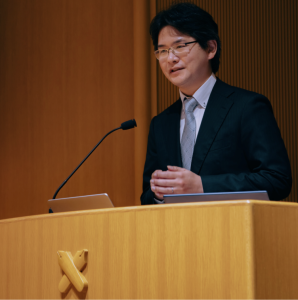
Masahiro Hashimoto
Lecturer, Department of Radiology, Keio University School of Medicine
“The Current State of Digital Transformation in Healthcare”
I am a physician specializing in radiology, specifically diagnostic imaging. The field of radiology has been relatively early in adopting DX.
CT, which stands for Computed Tomography, is a technology that uses computers to calculate and generate cross-sectional images. From its inception, CT has utilized digital technology. Nowadays, almost all images handled in hospitals are digitized. Radiologists often play a key role in promoting digitalization across the entire hospital, which is why I am speaking here today.
Deep learning has been a breakthrough technology, especially in imaging, and radiology was among the first fields to adopt it. The first AI product for image diagnosis sold in Japan was software that detected cerebral aneurysms from brain MRI images and highlighted potential aneurysm locations. Another AI product, designed to assist in diagnosing COVID-19 pneumonia, highlights suspected areas on images and analyzes the extent.
Other uses of AI include improving image quality. For MRI, there is a trade-off: shorter scan times result in lower image quality. AI-based correction techniques now enable the acquisition of high-quality images in shorter times. AI has also been applied to correct old CT images, but regulations prohibit using these corrected images for diagnosis, limiting practical use.
Among the AI products I have introduced, I find the “lung nodule detection AI” the most practical. This system automatically detects nodules (small tumors or abnormal shadows) in the lungs on CT images and marks them. However, it turns out that physicians do not widely use this system. Analysis of surveys revealed that experienced specialists tend to find that AI picks up too many irrelevant findings, which increases their workload.
The reason is that CT interpretation is not solely for finding lung nodules. The disadvantages of AI detecting too many unnecessary findings outweigh the benefits, leading to limited active use by physicians.
We are also experimenting with large language models (LLMs) in our hospital. We introduced an “AI Summary Creation” button in the electronic medical record system, which utilizes ChatGPT to summarize clinical notes. Interestingly, we found that the “optimal prompts” differ by department, team, and even individual, so that users can customize their prompts.
However, current LLMs have an issue called “hallucination,” where they generate inaccurate information, requiring cautious operation. Overcoming this problem is a key future challenge. Eliminating errors is a highly challenging task, making the use of AI for summary creation a problematic endeavor.
On the other hand, we are testing the use of AI in medical safety within imaging. In emergency departments, patients sometimes leave before radiologists have reviewed their CT scans, which can delay diagnosis. To prevent such incidents, we have utilized ChatGPT to read radiology reports and associated medical records, and issue warnings if it detects significant findings that have gone unnoticed by the primary physician. If a potentially hazardous case is identified, a warning screen appears, notifying the emergency safety manager.
We are adjusting prompts with emergency doctors, but hallucinations cannot be entirely prevented yet. Still, since humans perform the final checks in medical safety, we believe this use is relatively safe.
To summarize, deep learning has been used for improving image quality and detecting lesions, while LLMs have recently been applied to text-based tasks like summarizing clinical records. Additionally, ChatGPT occasionally struggles to differentiate between medically significant information and what is most important to patients. For example, it may capture events important to the patient but omit critical medical details. Prioritizing these correctly remains beyond the capabilities of current models.
Therefore, we believe that utilizing medical-specialized large language models, such as those developed by Sakura Internet, mentioned earlier, will lead to higher-precision summaries and improved clinical support in the future.

Koichi Hashida, Group Director, RIKEN Center for Advanced Intelligence Project
“Decentralized Personal-Data Utilization and Value Maximization by Personal AI”
Today, I will introduce the concept of Personal AI. Personal AI operates based on decentralized management of personal data (PD). Decentralized management means that individuals themselves control their own data. While consolidating data for many individuals in one place can be convenient, it also increases the risk of misuse. Therefore, decentralized management—keeping data separately for each individual—is considered safer.
Centralized management poses the risk of large-scale data breaches, but decentralization helps avoid such risks. Moreover, by keeping data in the hands of individuals, privacy can be protected while enabling data utilization. However, in some cases where optimization of society as a whole is necessary—such as disaster prevention, education, public health, and law enforcement—some degree of centralized management may be required. Still, for most services, decentralized management is better suited to leverage personal data effectively and create added value.
Personal AI refers to an AI dedicated to an individual user that interacts conversationally, understands the user’s needs, and finds and executes the most appropriate services. The technology is already feasible, and when implemented, it will enable people to easily access tailored services without needing to use multiple apps or websites. This also helps to close the digital divide caused by differences in IT literacy.
Furthermore, by utilizing PDS (Personal Data Stores), past service usage data can be stored and applied to other services. This will improve service accuracy and usability. It is expected that such systems will naturally become widespread in about a decade.
This is extremely convenient and will eventually automate many intermediary tasks, including retail and wholesale operations. For example, it could automate tax filing or simplify travel expense claims, handling many administrative tasks. It can also support behavioral change by nudging individuals toward healthier and more productive lifestyles.
Currently, some services that can be called “Personal AI” have already emerged. One example is Alibaba’s “Alipay” in China, which introduced AI chat functionality around October 2024. For instance, saying “I want to go from Beijing South Station to Tianjin Station tomorrow” results in the system suggesting appropriate transport options and completing the reservation. This service operates within Alibaba’s platform and is not open; all data exchanged is sent to Alibaba, raising some privacy concerns.
Hence, we are considering creating a more open system. We think it best to start implementing this in local government administrative services. Local governments offer hundreds of administrative services, but many residents do not fully understand their contents, and have limited ways to obtain proper information. Even if they find the right service, application procedures are often complicated. The goal is to automate this process.
This system is based on PDS, where various personal transaction data accumulates in the app, allowing individuals to maintain control over their information. Forms for applications are auto-filled from the data, saving effort. Moreover, personal data is not sent outside until the final submission, protecting privacy.
Additionally, the system can provide tailored information to people with specific needs. For example, an NPO offering consultation services for parents raising children with autism cannot obtain a list of such families from the city office. But if individuals have data about “having a child with autism” in their PDS, they can receive relevant support information through their Personal AI. These processes occur entirely on the individual’s device without a server, enabling safe operation with just an app.
This system can extend beyond administrative services to private-sector applications, anticipating widespread adoption. For instance, integrating supermarket and restaurant membership cards, coupons, and points into a single app increases the opportunities for everyday usage. Cooperation with local stores would encourage widespread use. Businesses benefit from accessing coupon usage and point update data, which aids in marketing. Demonstration experiments are underway, with the goal of a nationwide rollout.
With personal data on hand, input effort is reduced. Instead of linking to the city’s website, a click opens the application form directly, allowing online submissions with minimal additional information.
Key to widespread adoption are closing the digital divide and business cooperation. Risk management in operating such systems is essential, requiring appropriate legal frameworks. While we do not make laws, we have opportunities to engage with international standardization efforts at the right time.
I am involved in standardizing AI system input-output logs to facilitate management, operation, and reuse. In Europe, GDPR and the Data Act provide mechanisms for individuals to easily manage their data. Leveraging these capabilities enables Personal AI to manage and effectively utilize user data for both primary and secondary purposes. Personal AI intermediates services and prevents fraudulent online manipulations.
Service mediation involves two stages: “search and matching” and “execution of procedures.” If search and matching cover a wide range of products and services, targeted advertising becomes unnecessary. Without targeted ads, commercial incentives for fake news and echo chambers disappear, disrupting the current SNS business model.
Also, if Personal AI handles user interfaces during execution instead of service providers, manipulative “dark patterns” designed to coerce unwanted user actions become ineffective. Consequently, online behavioral manipulations such as fake news, echo chambers, and surveillance capitalism may be eliminated, solving problems in the current Internet business model.
Effectively leveraging Personal AI could also benefit the medical and healthcare fields. Personal AI could advise on exercise, diet, supplements, medication, treatment methods, and selecting appropriate medical institutions. If PDS integrates lifestyle and health data, individuals can use it for primary self-management. With proper anonymization, research institutions, pharmaceutical companies, and data/system providers can reuse data secondarily.
Aggregating data from many individual AI systems and providing analytical results to data users (such as research institutions) would enable more efficient medical data utilization. This might be referred to as a “decentralized biobank.”
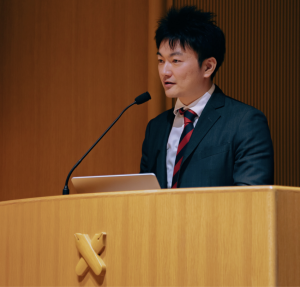
Shin Suzuki, Co-founder & Chief Development Officer, CureApp, Inc. / Medical Doctor
“New Digital Therapeutics in the Era of Generative AI”
Today, I will discuss “digital therapeutics,” also known as “therapeutic apps” in Japanese.
Digital therapeutics, often abbreviated as “DTx,” are a type of “SaMD” (Software as a Medical Device). This means software that has been officially approved by the government as having therapeutic effects and is recognized as a medical device. Therapeutic apps, like pharmaceuticals, undergo clinical trials to demonstrate their therapeutic efficacy, receive regulatory approval, and become eligible for insurance coverage before being marketed. Unlike conventional healthcare apps, these are not freely downloadable by anyone; instead, they are provided through prescriptions by physicians. That is, when a patient visits a hospital, the doctor prescribes the app, saying, “Let’s use this app for your condition.” This system features collaboration between the physician and patient through the prescription process. Data entered by patients into the app can be referenced by physicians during consultations, allowing for more informed treatment decisions. This is the overview of DTx.
Our company, CureApp, develops three of the five DTx products approved in Japan. Specifically, these are QupApp SC (a nicotine dependence treatment app), QupApp HT (a hypertension treatment app), and QupApp AUD (an alcohol dependence treatment app, provisional name). QupApp SC was approved in 2020. CureApp HT was launched in 2022 and is now used in over 3,500 medical institutions. Recently, in Japan, ADHD treatment games for children and insomnia treatment apps have also been approved, expanding the use of DTx.
Today, I’d like to discuss more advanced applications of generative AI. Until now, applications have been limited to relatively well-defined tasks, such as summarization or classification. We have worked closely with the PMDA (Japan’s regulatory agency for medical devices) to refine the software to avoid making inappropriate statements with care. As a result, functions like summarization and OCR are more readily accepted. However, with generative AI, we believe we can further expand therapeutic possibilities.
For example, generative AI can serve as a personal health coach. Humans have not only biological but also psychological and social dimensions, and their health changes daily in response to their social environment. For instance, shift workers who work at night and sleep in the morning may find typical advice such as “Measure your blood pressure in the morning” inappropriate. Such ultimate personalization, matching individual lifestyle habits, is difficult with conventional algorithms (expert systems) but can be more flexibly handled with generative AI.
Generative AI can also support the achievement of goals. While basic elements like “exercise” and “diet” remain unchanged in blood pressure management, the way to implement them can be discussed and tailored with the AI. For example, if the patient says, “I’m tired today, so I’ll do it tomorrow,” the AI can respond with encouragement or suggest a less demanding alternative. Additionally, consultation functions will improve. Current treatment apps use predefined options for queries, but generative AI will enable flexible dialogue tailored to each patient’s individual concerns.
So far, I have discussed the use of generative AI solely within therapeutic apps. However, combining these apps with device technologies can further expand their potential. For example, we are exploring a new device designed to help users avoid impulse purchases. The user would wear a device around their neck equipped with a camera, microphone, and speaker. It provides real-time guidance, such as “This meat has a lot of fat; you might want to choose a leaner option.”
Previously, users would learn from the app and gradually build awareness; however, with this device, it’s like having someone shop with you in real-time. It can say things like, “Don’t buy that now,” or “Stay away from the snack aisle.”
Some within the company have expressed discomfort, saying it feels like wearing a collar. Nevertheless, we see it as a form of behavioral nudging, encouraging better habits through gentle, real-time prompts.
Another example is talking with a “Master.” A stuffed toy placed in the living room might say, “You walked 12,000 steps today! Amazing!” This is also a therapeutic app. Notably, it is designed not to capture all meal information. The key is that it is a device you do not carry with you. Collecting all information can feel like constant surveillance. By contrast, the previous device is wearable, but this one is not, allowing for time without the device and creating a safe environment for consultation with a coach-like presence. Beyond behavior change, this approach could also be useful for evaluating Parkinson’s disease progression by assessing walking and hand movements and providing feedback for better care.
Lastly, I would like to mention the potential for blood pressure monitors themselves to play a coaching role at home. When users measure their blood pressure, they can input information such as “How was your day?” The device can then ask, “What did you eat today?” and provide advice like “It’s better to avoid this food tomorrow.” By prescribing such interactive blood pressure monitors, a more informed and personalized healthcare experience may be achieved.
So far, I have discussed technological possibilities; now, I will address practical challenges. Regulatory hurdles are significant, with strict standards for safety, quality, security, and privacy. It is essential to work closely with regulators and build consensus. Our company has been engaged in such efforts in the digital therapeutics field. However, we do not want to simply clear regulations by restricting app functions; instead, we aim to overcome challenges through technology.
To summarize, therapeutic apps are already utilizing generative AI, primarily in controllable tasks such as summarization and classification. Going forward, we aim to use generative tasks to provide interventions tailored to individual patients. Combining sensors and actuators will enable more advanced user experiences. Furthermore, we will continue to tackle regulatory barriers by addressing quality, safety, and security issues through technology, working in collaboration with relevant authorities.
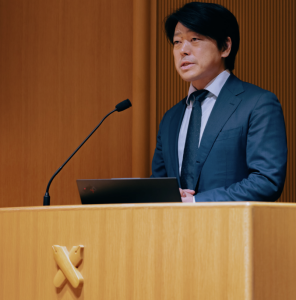
Kazunori Minato, CEO, TechDoctor, Inc.
“AI and Digital Biomarker Initiatives Addressing the Gap in Understanding Between Physicians and Patients”
We are engaged in the development of digital biomarkers. Our venture, originating from Keio University, recently completed a Series B funding round.
Supported by many companies, particularly domestic pharmaceutical firms, we are advancing research on digital biomarkers. Our goal is to utilize digital data to facilitate the more straightforward diagnosis of diseases that are otherwise difficult to diagnose.
Although AI may eventually assume diagnostic roles, we currently view it primarily as a tool for diagnostic support. For that to happen, it is crucial that AI accurately understands the disease states. Thus, we conduct research using wearable devices and daily data to visualize disease conditions and leverage them as digital biomarkers. We believe this approach will also expand AI’s potential in treatment applications and drug discovery.
Research on digital biomarkers is also gaining momentum overseas. In the early days of our company, this technology was sometimes dismissed as a “toy.” Still, now, with improvements in the accuracy of wearable devices, digital biomarkers have even been applied in infection assessment research.
By analyzing continuous data, new disease patterns and diagnostic indicators are emerging. This utilization of data enables us to capture signs of illness more clearly than the empirical observations traditionally made by physicians.
In clinical practice, many doctors see around 80 patients per day, leaving only a few minutes per patient. However, wearable devices can collect data 24/7 throughout the year, providing information previously unavailable in the examination room. This may significantly alter the nature of the doctor-patient relationship. Wearable devices and their data are something humanity is experiencing for the first time, and we anticipate witnessing profound changes in the future.
In the United States, digital biomarker development is well advanced, with over 393 digital endpoints already established. Collaborating with pharmaceutical companies both domestically and internationally, we have developed digital biomarkers for over 20 different diseases.
This allows us to understand disease states that were previously undetectable in clinical settings. Patients can also monitor changes in their condition at home, opening new possibilities in healthcare.
A psychiatric research team founded our company, and we focus particularly on supporting the diagnosis and treatment of mental illnesses. There are more than 50 psychiatric diagnoses, and even patients with the same diagnosis can present quite differently. We believe that digital biomarkers are effective in accurately capturing individual variations over time.
By utilizing this technology, physicians can monitor a significantly larger number of patients than they could see face-to-face each day and provide remote diagnostic support. Through app-based disease management informed by data, our goal is not to delegate diagnosis to AI, but to empower physicians to offer better care, even when they are not physically present.
In the future of medicine, doctors may utilize digital biomarkers to enhance their diagnostic expertise, effectively creating a “clone” that can help deliver optimal care to many more patients.
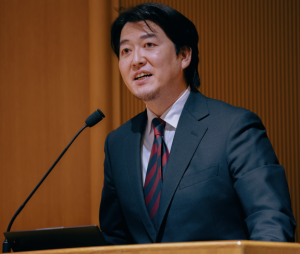
Keisuke Izumi, Chief Medical Officer, Co-Founder, TechDoctor, Inc.
“AI and Digital Biomarker Initiatives Addressing the Gap in Understanding Between Physicians and Patients”
First, let me discuss rheumatoid arthritis, one of the most common diseases we treat. This condition involves joint inflammation, causing pain and swelling, which can lead to deformities if untreated. There are approximately 700,000 to 1 million patients in Japan, with women affected about four times more than men.
Exercise has a significant impact on disease activity, and patients often ask for guidance on exercise. However, clear answers are complex, and advice usually boils down to “exercise moderately without causing pain.” Patients may feel fine during exercise but experience worsening joint inflammation later that day or the next, which can sometimes severely limit mobility. On the other hand, lack of exercise can lead to muscle weakness and reduced joint range of motion, making it challenging to tailor appropriate exercise levels individually.
Next, regarding the uneven distribution of rheumatoid arthritis specialists, there is a significant regional disparity in Japan, with a higher concentration of specialists in Kyushu and fewer in the northern and eastern regions. For example, Oita Prefecture has roughly ten times more specialists per population than Niigata Prefecture.
To address these challenges, since 2021, with support from the Japan Agency for Medical Research and Development (AMED), under the leadership of Dr. Yuko Kaneko at our department, we have been conducting research on remote consultations for rheumatoid arthritis using IoT digital devices.
Specifically, patients were provided with wearable devices and smartphones to record symptoms. We aimed to analyze the correlations between digital data and subjective symptoms, ultimately enabling the prediction of symptoms from digital data.
In this study, we utilized Google Fitbit to collect data on steps, heart rate, and sleep. We also used an app I developed over about ten years for collecting patient-reported outcomes (PROs) and clinical records, called “Kyo no Kansetsu.” In addition, small environmental sensors were deployed to analyze data correlations.
Over 12 weeks, patients visited the clinic every four weeks to register 150 patients.
Fitbit data provided metrics for heart rate, sleep, daytime activity, and exercise intensity. More recently, estimated blood oxygen saturation (SpO2), skin temperature, and respiratory rate have become available.
Patients’ symptom records were managed via a dedicated app and web-based dashboard. Patients could also take photos, supporting research using image analysis, which helps visualize daily joint conditions and treatment progress at a glance.
A physician dashboard attempts integration with electronic medical records (EMR), but due to security restrictions, data transfer is currently facilitated using QR codes.
Three hospitals participated in this study, centralizing clinical and wearable device data on a cloud database.
Real-time monitoring of device adherence was conducted, and individuals with poor compliance were contacted for follow-up.
This research suggests several benefits of digital biomarkers:
- Patients can quantify their condition, potentially enhancing shared decision-making.
- Adding digital biomarkers to conventional clinical practice transforms point-in-time data into continuous information from home, enabling more efficient assessment of disease states.
- Remote consultations may obtain information comparable to blood tests, increasing their utility.
- Use of digital biomarkers could standardize the quality of care across regions.
In discussions with pharmaceutical companies, it was pointed out that Japanese patients tend to endure pain silently, making conventional questionnaires less reliable for international comparisons. Objective digital biomarkers based on physiological data could compensate for such weaknesses, helping close gaps in understanding between doctors and patients and leading to more appropriate treatment.
Regarding this “gap in mutual understanding,” past research has shown that discordance between physician and patient perceptions of disease can delay improvement and increase the risk of joint destruction.
Japan’s aging population is also causing an increase in dementia cases. OECD data suggest that by 2035, over one-third of Japan’s population may have dementia. In clinical practice, we have observed an increasing number of patients with cognitive decline, which makes communication challenging. Digital biomarkers could help improve doctor-patient understanding and streamline care even in such situations.
Such digital biomarkers and AI-based care models are applicable not only in Japan but globally.
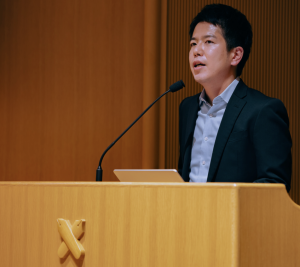
Sho Segawa, Representative Director, DATA HORIZON CO., LTD
“Better health while also having fun, even in the age of AI”
I would like to briefly introduce the DeNA Group’s healthcare business and then discuss our challenges and efforts as we transition into the AI era.
Last year, the Yokohama DeNA BayStars won the Japan championship for the first time in 26 years. DeNA originally developed its business centered around entertainment. Entertainment has the power to generate passion among many people, and beyond that, we want to leverage it to solve social issues. That is why we have been developing our healthcare business.
Specifically, as I will introduce later, we provide health services that incorporate elements of entertainment, encouraging consumers to take healthy actions while enjoying themselves. Our goal is to help optimize long-term medical costs. However, simply offering services is often insufficient to achieve significant results, such as optimizing medical expenses. Therefore, we present the accumulated data rigorously as evidence and move forward with initiatives with greater confidence.
One of the characteristics of our approach is combining DeNA’s originality in entertainment with digital transformation (DX), particularly in projects for local governments. Japan is an aging advanced country where many people move from corporate or association-based health insurance to municipal health insurance systems upon reaching the ages of 65 and 75. Addressing issues at this stage is still insufficient, so we are focusing our healthcare business on this challenge.
While it is relatively easy to distribute entertainment applications widely and have a large number of users, the situation is somewhat different in the healthcare domain. Merely distributing an app is not enough; the biggest challenge is ensuring people use it.
For example, no matter how excellent a health app is, it requires very active promotion for people to start using it. Municipalities that have adopted our apps hold face-to-face registration support events to lower the initial usage barrier and make a strong effort in sales activities.
In particular, with our long-established service “Kencom,” it has become clear that continuous use of the health app leads to results. Health apps like this cannot deliver expected effects unless users engage continuously, so we employ methods such as gamification. For instance, we host one of Japan’s most significant walking events, promoting communication among participants while incorporating an entertainment element.
Additionally, it is important to tailor approaches to the characteristics of each region. We introduced a mechanism that recognizes snow shoveling as a health activity, allowing users to earn points within the app. It has now become so established that “snow shoveling” ranks just after “walking” as a popular goal setting.
As shown, approaches to health promotion differ depending on region and age group, so incorporating them into daily life is a key point. For this reason, we currently collaborate with approximately 500 to 600 municipalities nationwide to provide support tailored to the unique characteristics of each community.
Moreover, while corporate health insurance unions achieve high medical consultation rates of 80-90%, municipal National Health Insurance averages about 30%. For people aged 75 and older under the latter-stage elderly healthcare system, the consultation rate drops to around 10%. To increase consultation rates, it is essential to integrate local perspectives with digital and AI technologies. Working with municipalities with limited resources, we analyze past data to identify who is more likely to seek medical consultation and proceed with more effective approaches.
In this way, we aim to encourage behavioral changes in consumers by leveraging digital technology and AI, while adapting our approach to the specific traits of each region. I believe the power that connects all this is community. Expanding the use of health services is a challenging task. Still, by creating systems that combine real-world and digital interactions, and by improving AI accuracy through the accumulation of data, we aim to support more effective and efficient public health initiatives and deliver better healthcare services.
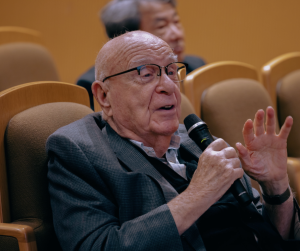
David Farber, Specially Appointed Professor, Graduate School of Law, Keio University / Co-Director, Cyber Civilization Research Center
“Closing Remarks”
Let me share a few thoughts from here. I found today to be fascinating—there were so many great ideas and thoughtful comments. I’d like to add just a slight note of caution, though.
We’re increasingly relying on having large amounts of personal information available online. However, the truth is that our computers aren’t secure. As they currently are, they can’t be made secure. So, putting all this information online—whether centralized or decentralized—can be risky, unless we seriously focus on improving the security of our core computing infrastructure. This has been an issue for many years, and it’s only becoming more critical.
Another point I find interesting is that each of us now carries a surprisingly powerful computer in our pockets. Even low-cost smartphones today are incredibly capable. Many of us also wear smartwatches, which are getting more innovative and more affordable. Most of these devices can run basic AI models, such as those based on large language models (LLMs), which opens up exciting possibilities for expanding access to healthcare worldwide.
One last point: I’ve spent some time in the U.S. working on efforts to standardize medical information. It might be a bit easier in Japan, but it’s definitely not simple anywhere. In the U.S., we’ve been trying for the past 20 years. Medicare may have provided some assistance, but not to a significant extent. And when you start looking across different countries, factors such as licensing, liability, and other regulatory issues make it even more complicated.
So while the potential is enormous, there’s still a lot of work to be done before we can fully implement these solutions in the way we hope to.

Sumio Matsumoto, Honorary Director, National Hospital Organization Tokyo Medical Center / Advisor, Ministry of Health, Labour and Welfare
“Closing Remarks”
Today, I intentionally asked ChatGPT about the issue of medical expenses. I posed the question: Is medical spending in Japan really high?
Looking at statistics from the first half of 2020, among 38 OECD member countries, the United States had the highest medical expenditure as a percentage of GDP at 17%, followed by Switzerland at 12.4%, Germany at 11.7%, and France at 11%. The average was 9%. Japan’s rate was 10.9%. This made me question whether this is truly an unsustainable burden for Japan’s finances.
From my extensive experience managing Tokyo Medical Center, I have witnessed firsthand how challenging it is to maintain the profitability of hospital operations under the current medical fee system, regardless of the efforts of healthcare providers. The reimbursement system is becoming even more stringent, and under the current framework, making hospital operations financially viable is very challenging.
When the da Vinci robotic-assisted surgery system was introduced into Japan’s public insurance system in 2012, I was involved as chair of the Ministry of Health, Labour and Welfare’s committee on insurance materials. The system faced criticism from the Central Social Insurance Medical Council for its high purchase cost—ranging from 100 million to several hundred million yen per unit—and the fact that it could only demonstrate non-inferiority compared to laparoscopic surgery. We debated whether it was necessary to introduce such an expensive device. I advocated for the benefits of easier surgery and reduced burden on surgeons. However, the discussion focused narrowly on the device’s price and slightly lower postoperative complication rates compared to laparoscopy. Unfortunately, the broader advantage of reducing human burden in surgery was not fully considered.
Later, with the emergence of more expensive molecular therapies and antibody drugs, the debate about cost-effectiveness seemed to fade. Subsequently, cost evaluation progressed, and the concept of “health technology assessment” became established.
Regarding system changes and budget discussions to address funding shortages under the medical fee system, ChatGPT responded that private medical insurance and patients’ out-of-pocket payments, especially for advanced treatments not covered by insurance, often influence the financial landscape. I wonder if this is truly acceptable and whether it should be discussed more broadly. Simply put, AI appears to suggest promoting mixed medical practice in Japan and funding it through means other than the national budget.
This is my personal view, not from ChatGPT, but I believe a crucial missing point in these debates is the hard work of clinicians and medical staff. Measures to reduce their burden are rarely properly evaluated financially, or if so, only minimally. I have high hopes that AI might help address this issue.
Finally, earlier, Dr. Hashida spoke about initiatives in Arao City, Kumamoto Prefecture. I would like to conclude by expressing my expectation that efforts utilizing AI and smartphones to enhance public literacy in healthcare and medical technologies will continue to advance.
(written by Hitomi Sano, photo by Shun Arima)
*Click here for the second half of the event report.
For previous articles, please refer to the link below:
Aug 18, 2022
【Event Report】The 1st Medical and Health DX Seminar
Nov 10, 2022
【Event Report①】The 2nd Medical and Health DX Seminar
【Event Report②】The 2nd Medical and Health DX Seminar
Jun 19, 2023
【Event Report①】The 3rd Medical and Health DX Seminar
【Event Report②】The 3rd Medical and Health DX Seminar
 Contact us
Contact us
